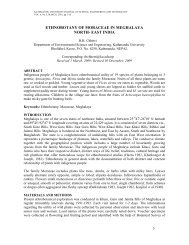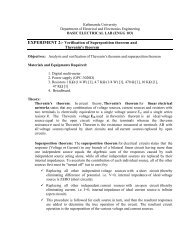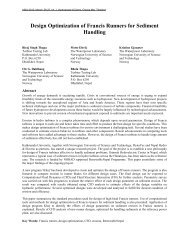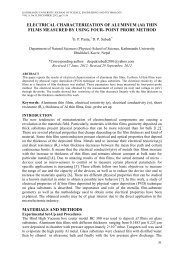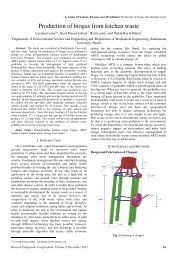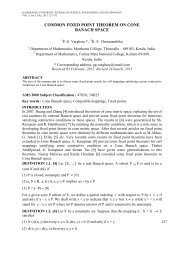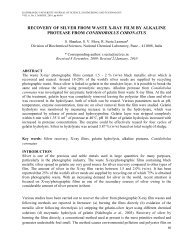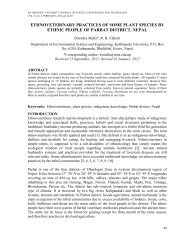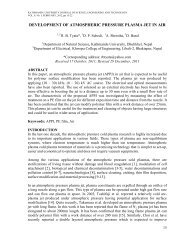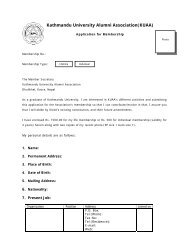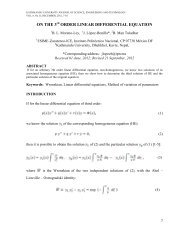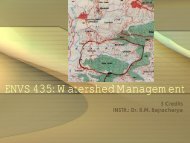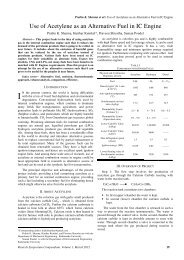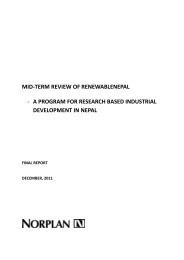monitoring of toxic metals - Kathmandu University
monitoring of toxic metals - Kathmandu University
monitoring of toxic metals - Kathmandu University
You also want an ePaper? Increase the reach of your titles
YUMPU automatically turns print PDFs into web optimized ePapers that Google loves.
KATHMANDU UNIVERSITY JOURNAL OF SCIENCE, ENGINEERING AND TECHNOLOGY<br />
VOL. 6, No. II, NOVEMBER, 2010, pp 60-65<br />
MONITORING OF TOXIC METALS (CADMIUM, LEAD, ARSENIC AND<br />
MERCURY) IN VEGETABLES OF SINDH, PAKISTAN<br />
1 Muhammad Abbas, 2 Zahida Parveen, 2 Muhammad Iqbal, 1 Riazuddin, 1 Sajid Iqbal, 1 Mubarik<br />
Ahmed, 3 Rashid Bhutto*<br />
1 Grain Quality Testing Laboratories, Karachi, Pakistan<br />
2 Pesticide Research Institute Southern-Zone Agricultural Center, Pakistan Agricultural Research<br />
Council, Karachi <strong>University</strong> Campus, Old Block No.9 and 10, Karachi-75270, Pakistan<br />
3 Department <strong>of</strong> Plant Breeding and Genetics, Sindh Agriculture <strong>University</strong>, Tandujam, Hydrabad<br />
*Corresponding author: bhutto_agricultural_2004@yahoo.com<br />
Received 9 March, 2010; Revised 14 July, 2010<br />
ABSTRACT<br />
A <strong>monitoring</strong> study was carried out with the aim to assess the level <strong>of</strong> <strong>toxic</strong> <strong>metals</strong> i.e., lead (Pb),<br />
cadmium (Cd), arsenic (As) and mercury (Hg) in different vegetables grown in Sindh province <strong>of</strong><br />
Pakistan during 2007-2008. Two hundred ten samples <strong>of</strong> twenty one vegetables were collected<br />
from farmers’ field <strong>of</strong> Sindh and exporters at Karachi. These samples were grouped into four<br />
categories viz., leafy, root and tuberous, cucurbits and fruity. The samples in duplicate were<br />
digested with nitric and perchloric acid mixture with 3:1 ratio. Cadmium and Pb were analyzed<br />
with Graphite Furnace Atomic Absorption Spectrophotometer and As and Hg on Atomic<br />
Absorption using Vapor and Hydride Generation Assembly. Average concentration <strong>of</strong> Cd, Pb, As<br />
and Hg in leafy vegetables was found 0.083 µgg -1 , 0.05 µgg -1 , 0.042 µgg -1 and 0.008 µgg -1<br />
respectively, in roots and tuberous vegetables was 0.057 µgg -1 , 0.03 µgg -1 , 0.045 µgg -1 & 0.004<br />
µgg -1 respectively, in cucurbit vegetables was 0.021 µgg -1 , 0.051 µgg -1 , 0.056 µgg -1 and 0.0089<br />
µgg -1 respectively and in fruity vegetables was 0.035 µgg -1 , 0.067 µgg -1 , 0.054 µgg -1 and 0.007<br />
µgg -1 respectively. In leafy vegetables, the concentration <strong>of</strong> cadmium, lead and mercury were<br />
found comparatively higher than other three groups <strong>of</strong> vegetables. However, concentration <strong>of</strong><br />
heavy <strong>metals</strong> found in the samples <strong>of</strong> all four categories <strong>of</strong> vegetables, was within the permissible<br />
limits and safe to consume.<br />
Keywords: Atomic Absorption Spectroscopy, Heavy Metals, Vegetables, Graphite Furnace,<br />
Vapor Generation and Hydride Generation<br />
INTRODUCTION<br />
Agriculture is a complex phenomenon and exerts both favorable and unfavorable consequences<br />
on environment (Ghandi, 2000). In Pakistan, agriculture is the mainstay <strong>of</strong> national economy. The<br />
sector receives second priority after defense. Its share in GDP is about 24%. It contributes 35 % to<br />
the export earnings and employs 51 % <strong>of</strong> total labor force and play vital role in uplifting the life <strong>of</strong><br />
70% <strong>of</strong> rural population. Besides, major crops <strong>of</strong> Pakistan, vegetables are grown widely sufficient<br />
quantities <strong>of</strong> some vegetables such as chili, tomato etc. are exported to various countries. In<br />
Pakistan, share <strong>of</strong> vegetable export is about 0.22% (Government <strong>of</strong> Pakistan 2008-09).<br />
60
KATHMANDU UNIVERSITY JOURNAL OF SCIENCE, ENGINEERING AND TECHNOLOGY<br />
VOL. 6, No. II, NOVEMBER, 2010, pp 60-65<br />
Soil and environmental pollution is a matter <strong>of</strong> great concern and has been accepted as a global<br />
problem because <strong>of</strong> its adverse effect on human health, plants, animals and all exposed material to<br />
Cd, Pb, As and Hg (Irshad et al. 1997). Heavy metal <strong>toxic</strong>ity has received special attention<br />
globally due to neurotoxin, carcinogenic and several other impacts arising from their consumption<br />
even at lower contents. (Sathawara, et al., 2004). Prolonged accumulation <strong>of</strong> heavy <strong>metals</strong><br />
through food stuff may lead to chronic effect in the kidney and liver <strong>of</strong> humans and causes<br />
disruption <strong>of</strong> numerous biochemical processes leading to cardiovascular, nervous, kidney and<br />
bone diseases (Jarup, 2003). Modern analytical techniques and ultra sensitive instruments<br />
analyzing metal contents even at ppb levels have recently resolved several health disorders<br />
associated with intake <strong>of</strong> <strong>toxic</strong> <strong>metals</strong>. Recent developments in <strong>toxic</strong>ities and other disorders<br />
resulting from ingestion <strong>of</strong> <strong>toxic</strong> <strong>metals</strong> have compelled food regulators around the world to<br />
revise the safe limits <strong>of</strong> these <strong>toxic</strong>ants to ensure consumer health.<br />
Soil eco-system throughout world has been contaminated with heavy <strong>metals</strong> by various human<br />
activities and movement <strong>of</strong> <strong>metals</strong> in food chain has become human health hazard (Zahir et al.,<br />
2009). Land contamination with heavy <strong>metals</strong> is increasing and becoming environmental,<br />
economic and planning issue in Pakistan (Bhutto et al., 2009).<br />
Soil chemical composition plays important role in composition <strong>of</strong> plant materials. Overall <strong>toxic</strong><br />
metal availability in soil rhizosphere contributes to metal contents in fruits/ vegetables.<br />
Anthropogenic activity such as application <strong>of</strong> fertilizers, manures also affect soil metal content<br />
(e.g. phosphatic fertilizers being main source <strong>of</strong> Cd impurity). Soils in Pakistan contain Pb and Cd<br />
at sufficient levels (Ahmed et al., 1994). Perveen et al. (2003) reported the presence <strong>of</strong> Cd and Pb<br />
concentration <strong>of</strong> 0.08 µgg -1 and 0.12 µgg -1 respectively <strong>toxic</strong> <strong>metals</strong> at lower concentration.<br />
Sharma et al. (2009) also reported Cd, Pb and As at 0.6 µgg -1 , 0.15 µgg -1 and 0.008 µgg -1<br />
respectively in leafy and fruity vegetables. Leafy vegetables accumulate much higher contents <strong>of</strong><br />
heavy <strong>metals</strong> as compare to other vegetables because leafy vegetables are most exposed to<br />
environmental pollution because <strong>of</strong> large surface area (Itanna et al., 2002). Considering the<br />
significance <strong>of</strong> these <strong>metals</strong> and food consumption patterns, a detailed study was carried out to<br />
monitor levels <strong>of</strong> lead, cadmium, arsenic and mercury in different vegetables grown in the<br />
province <strong>of</strong> Sindh. The aim <strong>of</strong> this study was to monitor the <strong>toxic</strong> heavy <strong>metals</strong> Cd, Pb, As and Hg<br />
in vegetables.<br />
MATERIALS AND METHODS<br />
Two hundred ten (210) samples <strong>of</strong> vegetables i.e. leafy vegetables (Coriander, Methi, Spinach and<br />
Mint), root and tuberous vegetables (Arum, Onion, Potato, Radish, Sugar Beet and Turnip),<br />
cucurbit vegetables (Bitter Gourd, Cucumber, Indian Squash and Pumpkin) and fruity vegetables<br />
(Brinjal, Cabbage, Cauliflower, Chilies, French Beans, Okra and Tomato) were collected from<br />
farmers’ field <strong>of</strong> Khairpur, Sukkur, Hydrabad and Karachi district and from exporters <strong>of</strong> Karachi.<br />
Samples were placed in polyethylene bags and brought to laboratory for analysis. All samples<br />
were washed with tape water followed with DDI (double de-ionized distil water). Samples were<br />
cut in into small pieces and dried at 105°C for 18 hours (Wiermans et al., 1986). After drying the<br />
samples were ground into powder form. Approximately 1.0 g <strong>of</strong> each sample in duplicate taken<br />
into digestion tubes, were soaked in 40ml <strong>of</strong> nitric acid and perchloric acid (3:1) and left<br />
overnight for complete contact <strong>of</strong> material. Next day, samples were digested first at 120°C for 2<br />
hrs and then 180°C on heating digester (VELP Scientifica) till the solution becomes transparent.<br />
Digestion stopped when sample solution reduced to 2-3 ml. Cooled samples were transferred into<br />
61
KATHMANDU UNIVERSITY JOURNAL OF SCIENCE, ENGINEERING AND TECHNOLOGY<br />
VOL. 6, No. II, NOVEMBER, 2010, pp 60-65<br />
100 ml volumetric flask and volume raised up to the mark with 0.1 M HNO 3 (AOAC 2000). All<br />
glasswares including digestion tubes were soaked with 30% HNO 3 for 8 hours and finally washed<br />
with DDI water (Robert et al., 1987). Following the instruction <strong>of</strong> Instrument operational manual<br />
provided by manufacturer, analysis <strong>of</strong> Cd, Pb, As and Hg was carried out using Atomic<br />
Absorption Spectrophotometer coupled with Graphite Furnace and Vapor and Hydride generation<br />
assembly. Cadmium and Pb was analyzed on Graphite Furnace Atomic Absorption<br />
Spectrophotometer and As and Hg on Atomic Absorption using Vapor and Hydride Generation<br />
Assembly.<br />
RESULTS AND DISCUSSION<br />
Heavy <strong>metals</strong> are <strong>of</strong> great significance in ecochemistry and eco<strong>toxic</strong>ology because <strong>of</strong> their<br />
<strong>toxic</strong>ity at low levels and tendency to accumulate in human organs (Viqar et al 1992). The results<br />
obtained are given in Table 2 to 4. The dietary limit in food and food stuff for cadmium is 0.1<br />
µgg -1 (Table 1). High concentration <strong>of</strong> cadmium exerts detrimental effects on human health and<br />
causes severe diseases such as tubular growth, kidney damage, cancer, diarrhea and incurable<br />
vomiting. Results <strong>of</strong> the study (Table 2 to 4) show that among the four groups <strong>of</strong> vegetables, the<br />
maximum concentration (0.09 µgg -1 ) <strong>of</strong> cadmium was found in leafy vegetables (fenugreek/<br />
methi) whereas the minimum concentration (0.002 µgg -1 ) was in cucurbit vegetables (Indian<br />
squash). Nergus et al. (2005) also reported high concentration (2.5 µgg -1 ) in fenugreek/<br />
methi).The concentration <strong>of</strong> lead if exceeding the maximum permissible limits (0.2 µgg -1 ) in<br />
human, affect nervous system, bones, liver, pancreases, teeth and gum & causes blood diseases.<br />
Results <strong>of</strong> our study show that maximum concentration (0.15 µgg -1 ) <strong>of</strong> lead was found in leafy<br />
vegetables (coriander) and the minimum concentration (0.001 µgg -1 ) in root/ tuberous vegetables<br />
(sugar beet). Parveen et al (2003) also reported the similar trend <strong>of</strong> lead distribution in vegetables.<br />
Mercury is more <strong>toxic</strong> than Cd and Pb. The concentration <strong>of</strong> mercury exceeding the maximum<br />
permissible limit (0.03 µgg -1 ) in food and food stuff cause serious health problems such as loss <strong>of</strong><br />
vision, hearing and metal retardation and finally death occurs. This study show that the maximum<br />
concentration (0.02 µgg -1 ) <strong>of</strong> mercury was found in leafy vegetables (fenugreek/ methi) and the<br />
lower concentration (0.001 µgg -1 ) was found in root/ tuberous vegetables (potato and turnip).<br />
Arsenic is extremely <strong>toxic</strong>. The concentration <strong>of</strong> arsenic exceeding the maximum permissible<br />
limit (0.03 µgg -1 ) in foodstuff cause short term (nausea, vomiting, diarrhea, weakness, loss <strong>of</strong><br />
appetite, cough and headache) and long term (cardiovascular diseases, diabetes and vascular<br />
diseases) health effects. Results show that the maximum concentration (0.083 µgg -1 ) <strong>of</strong> arsenic<br />
was found in fruity vegetables (okra) whereas the minimum concentration (0.014 µgg -1 ) was also<br />
detected in vegetables (cauliflower).<br />
Table 1: Permissible limits (FAO/WHO 1999) <strong>of</strong> the <strong>metals</strong> (µgg -1 )<br />
Permissible<br />
Limits<br />
Cadmium Lead Arsenic Mercury<br />
0.1 0.2 0.1 0.03<br />
62
KATHMANDU UNIVERSITY JOURNAL OF SCIENCE, ENGINEERING AND TECHNOLOGY<br />
VOL. 6, No. II, NOVEMBER, 2010, pp 60-65<br />
Table 2: Concentration (µgg -1 ) <strong>of</strong> <strong>toxic</strong> <strong>metals</strong> in leafy vegetables<br />
S # Commodity<br />
No. <strong>of</strong><br />
Average metal concentration (µgg -1 )<br />
samples Cd Pb As Hg<br />
1 Coriander 10 0.084<br />
±0.005<br />
0.150**<br />
±0.0055<br />
0.031<br />
±0.0028<br />
0.001*<br />
±0.00024<br />
2 Fenugreek/ Methi 10 0.090**<br />
±0.0035<br />
0.059<br />
±0.0036<br />
0.065**<br />
±0.0036<br />
0.020**<br />
±0.0008<br />
3 Spinach 10 0.087<br />
±0.003<br />
0.010*<br />
±0.0011<br />
0.016*<br />
±0.0017<br />
0.009<br />
±0.00021<br />
4 Mint 10 0.071*<br />
±0.003<br />
0.012<br />
±0.0013<br />
0.057<br />
±0.003<br />
0.005<br />
±0.00022<br />
± = Standard deviation<br />
* = Minimum concentration<br />
** = Maximum concentration<br />
Table 3: Concentration (µgg -1 ) <strong>of</strong> <strong>toxic</strong> <strong>metals</strong> in root/ tuberous vegetables<br />
S<br />
No. <strong>of</strong><br />
Average metal Concentration (µgg -1 )<br />
Commodity<br />
#<br />
samples Cd Pb As Hg<br />
1 Arum 10 0.086**<br />
±0.0037<br />
0.022<br />
±0.002<br />
0.017*<br />
±0.0024<br />
0.010**<br />
±0.00085<br />
2 Onion 10 0.079<br />
±0.0048<br />
0.006<br />
±0.001<br />
0.023<br />
±0.0024<br />
0.009<br />
±0.00053<br />
3 Potato 10 0.040*<br />
±0.0031<br />
0.091**<br />
±0.0044<br />
0.025<br />
±0.0022<br />
0.001*<br />
±0.00010<br />
4 Radish 10 0.045<br />
±0.003<br />
0.043<br />
±0.0026<br />
0.090**<br />
±0.0030<br />
0.005<br />
±0.00022<br />
5 Sugar beet 10 0.047<br />
±0.0035<br />
0.001*<br />
±0.0002<br />
0.038<br />
±0.0027<br />
0.005<br />
±0.00030<br />
6 Turnip 10 0.050<br />
±0.0033<br />
0.019<br />
±0.0014<br />
0.081<br />
±0.0051<br />
0.001*<br />
±0.00016<br />
Table 4: Concentration (µgg -1 ) <strong>of</strong> <strong>toxic</strong> <strong>metals</strong> in cucurbit vegetables<br />
S<br />
No. <strong>of</strong><br />
Average metal Concentration (µgg -1 )<br />
Commodity<br />
#<br />
samples Cd Pb As Hg<br />
1 Bitter gourd 10 0.016<br />
±0.0020<br />
0.018*<br />
±0.0017<br />
0.039*<br />
±0.0025<br />
0.0091<br />
±0.0005<br />
2 Cucumber 10 0.037**<br />
±0.0039<br />
0.069**<br />
±0.005<br />
0.042<br />
±0.0032<br />
0.0056*<br />
±0.0004<br />
3 Indian<br />
Squash<br />
10 0.002*<br />
±0.00047<br />
0.055<br />
±0.004<br />
0.090**<br />
±0.0026<br />
0.0110**<br />
±0.00067<br />
4 Pumpkin/<br />
Loki<br />
10 0.032<br />
±0.0032<br />
0.065<br />
±0.0067<br />
0.053<br />
±0.0042<br />
0.0100<br />
±0.00075<br />
63
KATHMANDU UNIVERSITY JOURNAL OF SCIENCE, ENGINEERING AND TECHNOLOGY<br />
VOL. 6, No. II, NOVEMBER, 2010, pp 60-65<br />
Table 5: Concentration (µgg -1 ) <strong>of</strong> <strong>toxic</strong> <strong>metals</strong> in fruits vegetables<br />
S<br />
No. <strong>of</strong><br />
Average metal Concentration (µgg -1 )<br />
Commodity<br />
#<br />
samples Cd Pb As Hg<br />
1 Brinjal 10 0.025<br />
±0.0031<br />
0.036<br />
±0.0042<br />
0.035<br />
±0.0039<br />
0.007<br />
±0.00056<br />
2 Cabbage 10 0.049<br />
±0.0061<br />
0.084<br />
±0.0061<br />
0.091**<br />
±0.0106<br />
0.003*<br />
±0.00042<br />
3 Cauliflower 10 0.075**<br />
±0.0064<br />
0.088<br />
±0.0105<br />
0.014*<br />
±0.0024<br />
0.009<br />
±0.00103<br />
4 Chilies 10 0.018<br />
±0.0034<br />
0.041<br />
±0.0054<br />
0.053<br />
±0.0068<br />
0.010**<br />
±0.00113<br />
5 French<br />
beans<br />
10 0.029<br />
±0.0037<br />
0.089**<br />
±0.0108<br />
0.080<br />
±0.0093<br />
0.008<br />
±0.00102<br />
6 Okra 10 0.013*<br />
±0.0024<br />
0.064<br />
±0.0062<br />
0.083<br />
±0.0073<br />
0.009<br />
±0.00100<br />
7 Tomato 10 0.071<br />
±0.0086<br />
0.009*<br />
±0.0017<br />
0.025<br />
±0.0038<br />
0.005<br />
±0.00072<br />
CONCLUSION AND RECOMMENDATION<br />
Present study shows that the concentration <strong>of</strong> cadmium, lead and arsenic were comparatively high<br />
in leafy vegetables. The reason for this trend is because <strong>of</strong> high translocation and transpiration<br />
rate <strong>of</strong> leafy vegetables in which transfer <strong>of</strong> <strong>metals</strong> from root to stem and ultimately to fruit is<br />
longer which results in lower accumulation other than leafy vegetables. Objective <strong>of</strong> this study<br />
was to monitor the levels <strong>of</strong> <strong>toxic</strong> heavy <strong>metals</strong> (Cd, Pb, As and Hg) in different vegetables grown<br />
in Sindh. Results revealed that the studied vegetables grown in Sindh, Pakistan, contain only the<br />
trace amount <strong>of</strong> these <strong>toxic</strong> <strong>metals</strong>. The concentrations found were within the permissible limits<br />
given by W.H.O/ F.A.O (1999) and safe in consumption point <strong>of</strong> view.<br />
ACKNOLEDGMENT<br />
We express our sincere gratitude to honorable Chairman, Pakistan Agricultural Research Council<br />
(PARC), Member (Crop Science), PARC and Executive Director, ALP-Project for their kind<br />
approval <strong>of</strong> this project.<br />
REFERENCE<br />
1. Ahmed S, Waheed S, Mannan A, Fatima I & Qureshi I H 1994. Evaluation <strong>of</strong> trace<br />
elements in wheat and wheat by-products. J.AOAC. 77: 11.<br />
2. Bhutto M A, Zahida P, Riazuddin, Sajid I, Mubarik A, & Sahar N, 2009. Monitoring <strong>of</strong><br />
heavy and essential trace <strong>metals</strong> in wheat procured form various countries. Int. J. Biol.<br />
Biotech., 6(4): 247.<br />
3. FAO/WHO 1999. Expert Committee on Food Additives, Summary and conclusions, 53rd<br />
Meeting, Rome.<br />
64
KATHMANDU UNIVERSITY JOURNAL OF SCIENCE, ENGINEERING AND TECHNOLOGY<br />
VOL. 6, No. II, NOVEMBER, 2010, pp 60-65<br />
4. Ghandi Z, 2000. Permission threshold values <strong>of</strong> some pollutants in production <strong>of</strong> free<br />
pollution vegetables. Chemical Abst. 461.<br />
5. Government <strong>of</strong> Pakistan, Economic Survey <strong>of</strong> Pakistan. Economic Advisory Wing,<br />
Finance Division Islamabad, 2 (2008-09) 17.<br />
6. Irshad A S, and Jan M R, 1997. Physico-chemical studies <strong>of</strong> polluants. Prco. NSMTCC 97<br />
on Environmental Pollution. Feb.24-26. Islamabad, Pakistan<br />
7. Itanna F, 2002. Metals in leafy vegetables grown in Addis Ababa and <strong>toxic</strong>ological<br />
implications. Ethiopian. J. Health Dev, 6: 295.<br />
8. Jarup L, 2003. Hazards <strong>of</strong> heavy metal contamination. Br. Med. Bull. 68: 167.<br />
9. Nergus Y, Ahmed S I, and Sharif M, 2005. Impact <strong>of</strong> contaminated vegetables, fruits and<br />
fodders on human health by Malir river farms Karachi. J. Chem. Soc. Pak. 6: 561.<br />
10. Perveen Z, Khuhro M I, and Rafiq N, 2003. Market basket survey for lead, cadmium,<br />
copper, chromium and zinc in fruits and vegetables. Bull. Environ. Contam. Toxicol. 71:<br />
1260.<br />
11. Robert W, & Glandys Lacroix M A 1987. Total arsenic in food after wet and dry digestion<br />
and co-precipitate with ammonium pyrollidine dithiocarbamate using Graphite Furnace<br />
Atomic Absorption Spectrophotometer. J. A.O.A.C. 70(5): 866.<br />
12. Sathawara, N G, Parikh D J, & Agarwal Y K, 2004. Essentail heavy <strong>metals</strong> in<br />
environmental samples from western India. Bul. Environ. Contam. Toxicol., 73: 756.<br />
13. Sharma R K, Agrawal M, and Marshal F M, 2009. Heavy <strong>metals</strong> in vegetables collected<br />
from production and market sites <strong>of</strong> a tropical urban area <strong>of</strong> India. Food Chem Toxicol.<br />
47(3): 583.<br />
14. Viqar N, and Ahmed R, 1992. Decomposition <strong>of</strong> Vegetables for determination <strong>of</strong> Zn, Cd,<br />
Pb and Cu by stripping voltammerty. Mikrochim. 106: 137.<br />
15. Wiermans D, and Ven Goor B G, 1986. Cadmium, lead, mercury and arsenic<br />
concentration in crops and corresponding soil in Netherlands. J Agric. Food Chem. 34:<br />
1067.<br />
16. Yousufzai A H K, Hashmi D R, Ahmed F, and Durrani K, 2001. Heavy metal<br />
accumulation in roadside vegetation <strong>of</strong> urban areas <strong>of</strong> Karachi. Pak. J. Sci. Ind. Res. 44:<br />
29.<br />
17. Zahir E, Imran I, and Mohyuddin S, 2009. Market Basket Survey <strong>of</strong> selected <strong>metals</strong> in<br />
fruits from Krachi city (Pakistan). J.basic appl. Sci. 5(2): 47.<br />
65



